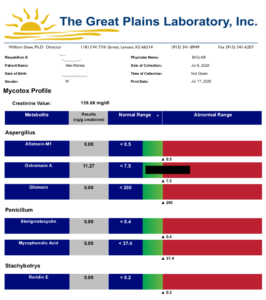Welcome to my blog on Ochratoxin A: High Ochratoxin A: What Does It Mean?
After writing the master blog called The Ultimate Guide To Mycotoxins I thought I would write smaller blogs on each of the main mycotoxins. Ochratoxin A is the most common mycotoxin I find in testing. I.
You might also be interested in the section of my blog deduced to the topic of mycotoxins, click here. Posts include:
- Ochratoxin A Toxicity: Antioxidants Are To The Rescue!
- How To Know If You Have Mycotoxins: Symptoms And Testing
- Mycotoxin Testing: Everything You Need To Know
- Detoxify Mould And Mycotoxns With Liposomal Glutathione
- Can mould and mycotoxins cause chronic fatigue syndrome?
- Can mould and mycotoxins cause gut problems such as IBS?
What Is Ochratoxin A?
Ochratoxin A (OTA) is a mycotoxin produced by several fungal species including Aspergillus ochraceus, A. carbonarius, A. niger and Penicillium verrucosum.
Why Do I Have High Levels Of Ochratoxin A?
There are two ways we may be exposed to ochratoxin A:
- Via our diet.
- Via breathing it in when we live in a property with water damage such as a water leak (or just visible mould)
What Effect Does It Have In Humans?
A 2020 study reviewed the epidemiological literature on Ochratoxin A exposure and adverse health effects in different populations worldwide, and assessed the potential human health risks of ochratoxin A exposure. It concluded:
With one exception, there appears to be no statistically significant evidence for human health risks associated with ochratoxin A exposure.
One Egyptian study showed a significantly higher risk of nephritic syndrome in those with very high urinary ochratoxin A levels compared with relatively unexposed individuals; however, other potential risk factors were not controlled for in the study.
The authors of the paper concluded that “larger cohort or case-control studies are needed in the future to better establish potential OTA-related human health effects, and further duplicate-diet studies are needed to validate biomarkers of OTA exposure in humans.”
However it is important to highlight that The International Agency for Research on Cancer (IARC) has classified OTA as a Group 2B possible human carcinogen, based on demonstrated carcinogenicity in animal studies, although OTA-related carcinogenicity has not been conclusively determined in humans.
Also the evidence reviewed in this study was primarily looking at human exposure to ochratoin A via diet, rather than a water-damaged, mouldy, building. It is the latter, in my experience, which can lead to chronic health issues due to the magnitude of the exposure.
Further to that, a paper out this year (2022) is entitled “Ochratoxin A as an alarming health threat for livestock and human: A review on molecular interactions, mechanism of toxicity, detection, detoxification, and dietary prophylaxis”
Finally a paper from 2016, performed a careful analyses of the data and showed that OTA cancer-causing effects are due to combined direct and indirect mechanisms (e.g., genotoxicity, oxidative stress, epigenetic factors) and concluded that:
Altogether this provides strong evidence that OTA carcinogenicity can also occur in humans.
What Foods Are High In Ochratoxin A?
- Coffee (that’s why I recommend Exhale coffee which is independently tested to be free of mycotoxins).
- Oats and other unprocessed cereals including rye, buckwheat, wheat, maize, millet and barley
- Dried vegetables and olives
- Smoked and salted dried fish, dried beans, biltong, soya beans, chickpeas, rapeseed, pepper, dried fruit, and sesame seeds, nuts.
- Grapes and grape products, including table grapes, wines, and dried vine fruits.
- Apples, pears, peaches, citrus, figs, strawberries, mangoes, tomatoes, melons, onions, garlic, and yams.
- Cheese, meat products.
- Pork*
*It is frequently found in pork intended for human consumption. Ochratoxin is believed to be responsible for a ‘porcine nephropathy’ that has been studied intensively in the Scandinavian countries. The disease is endemic in Denmark, where rates of porcine nephropathy and ochratoxin contamination in pig feed are highly correlated
It is NOT recommended to avoid all these products – this list simply shows where Ochratoxin A has been detected.
For the coffee lovers among you, I highly recommend checking out Exhale Coffee. They have selected coffee beans which are have confirmed in laboratory testing to be free of mycotoxins and other nasties such as pesticides and metals, as well as being the highest in the good stuff such as chlorogenic acid – one of the most researched compounds in coffee that provides so many of its health benefits. Check out my blogs on coffee here.
The EFSA have now used a more conservative approach by calculating margin of exposure and concluded that there is a health concern for most consumers groups. EFSA’s scientific advice will inform the European Commission in the ongoing discussion on maximum levels of OTA in foodstuffs.
Watch my interview with Dr. Jill Crista, author of Break The Mold:
Ochratoxin A And Human Health
Ochratoxin A has been shown to be toxic and carcinogenic in animals.
The kidney is the main target organ for ochratoxin A. Other adverse effects include:
- Liver toxin
- Immuno suppressant
- Inhibition of macromolecular synthesis
- Increased lipid peroxidation (cellular damage)
- Inhibits mitochondrial ATP production (effecting energy production)
The International Agency for Research on Cancer (IARC) has classified Ochratoxin A as a Group 2B possible human carcinogen, based on demonstrated carcinogenicity in animal studies.
A recent study showed Ochratoxin A triggered autism via epigenetic mechanism (Mezzelani et al., 2016).
Ochratoxin A altered nutrient absorption in the intestine and, in addition, Ochratoxin A-treated animals experienced faster and more harmful parasite infections. Also, OTA-has also been found to cause intestinal permeability via oxidative stress.
OTA exerted its effect on gut via the reduction of nutrient absorption, disruption of intestinal permeability, cell apoptosis, and modulation of immune system.
What Are The Symptoms of Ochratoxin A?
Symptoms will vary from person to person depending in their individual health status but common symptoms include:
- IBS
- Brain fog
- Chronic fatigue
- Depression or low mood
- Skin conditions such as rashes
- Sinusitis
- Allergies and histamine issues
The list could go on and on but these are certainly the most common symptoms I see in my clientele.
Testing & Treatment For Ochratoxin A?
You can test for mycotoxins in the urine. Great Plains Laboratory (a US based lab) have a mycotoxin urine profile. The below is a sample of my own mycotoxin test results indicating an abnormal range for Ochratoxin A. Re-testing may be helpful to understand how successful you have been in treatment of Ochratoxin A.
There are other tests that can be considered to have a more complete understanding of an individuals health. These include:
- Microbiome testing – mycotoxins can cause significant disruption to the gut function.
- Organic acid testing – this is a urine test that both looks as fungal metabolites but also nutrient status. Nutrient deficiencies may impact on many aspects of health including detoxification capacity which is essential to optimise when wanting to heal from mould illness. One test, available from Genova, looks at lipid peroxides – which was mentioned earlier can be elevated as a consequence of ochratoxin exposure.
- Functional blood testing.
How Do I Avoid Exposure To Ochratoxin A?
Treatment of ochratoxin A requires a reduction in exposure to the toxin. The World Health Organisation advise the consumer to:
- Carefully inspect whole grains and nuts for evidence of mould, and discard any that look mouldy, discoloured, or shriveled.
- Buy grains and nuts as fresh as possible; that have been grown as close to home as possible, and which have not been transported over a long time
- Buy only reputable brands of nuts and nut butters – moulds are not entirely killed by processing or roasting, so can show up in products e.g. peanut butter
- Make sure that foods are stored properly and are not kept for extended periods of time before being used
- Try to ensure his/her diet is diverse; this not only helps to mitigate aflatoxin exposure, but also improves health and nutrition. Consumers who lack dietary diversity need to pay extra attention to minimize the risk of high exposure to aflatoxins. For example, extensive aflatoxin exposure has been reported from areas where people get a major part of their daily calorie intake from maize; this foodstuff is commonly contaminated with aflatoxins and needs to be handled properly both before and after harvest.
However, this is not considering the mycotoxins that might be produced from water-damaged buildings – really the most common cause of mould illness. In these situations, leaving the property *may* be needed. There are other considerations also, as I appreciate this is sometimes just not achievable. I have had clients sleep in tents in the garden, when levels of mould were significant, because they were aware of how they felt on entering their home.
Check out my article The Ultimate Guide To Mycotoxins for more information.
Listen and learn from my interview with Vivien Allred as she shares her recovery story:
How Do You Treat Ochratoxin A?
Treat the individual, not the disease.
Check out my article ‘Ochratoxin A Toxicity: Antioxidants To The Rescue!’
What the above quote means is we need to focus on your unique case. There are numerous things that may require support ranging from small intestine bacterial overgrowth, to bile support, histamine issues and mast cell activation syndrome to fibromyalgia. Treatment will require layering and must be sequential – I often describe it as chapters in a book.
Check out my article The Ultimate Guide To Mycotoxins which provides a more in-depth summary of testing and treatment for mycotoxins.
I would like to point out straight away that first off you HAVE to ensure you are no longer being exposed to mould. There is a saying in Functional Medicine which is “you can’t get well in the same environment that made you sick”.
Once you have removed yourself from the exposure we need to understand how these mycotoxins have effected you, and where there may have colonised.
The sinuses is a common place of colonisation (contributing to sinusitis for example) and a great product to help with this is a nasal spray which can be found here on Amazon.
Options for ochratoxin A treatment may include:
- Binders such as charcoal.
- Anti-fungals such as oregano oil .
- Glutathione to support detoxification. Certain mycotoxins have been found to inhibit the enzymes required for the endogenous production of glutathione and thus supplementation may be important. Another option is NAC which supports glutathione status.
- Anti-inflammatories and anti-oxidants such as turmeric, rosemary and omega 3 fatty acids, vitamin C, selenium.
- Probiotics – certain strains have been found to assist the detoxification/binding of mycotoxins.
- Bitters or phosphatidylcholine for bile/detox support. Bitters and phosphatidylcholine both support bile and bile has anti-bacterial and anti-fungal properties making them helpful additions to a protocol for both mould and SIBO/SIFO.
The Importance Of Gut Health In Ochratoxin A Treatment
Given the important metabolism of ochratoxin A that occurs in the gut, and evidence of increased toxicity when gut microbiome is disturbed with an antibiotic, it would pay to direct attention toward achieving and maintaining healthy gastrointestinal functioning. In fact, there is evidence that some beneficial gastrointestinal flora can have positive effects on decreasing toxicity from OTA including specific strains of yeast (12).
Sauna therapy may also be helpful in ochratoxin A treatment because it has been detected in human sweat.
Mycotoxins, as with any condition/topic, needs to be put in context with everything else that might be going on in the individual – small intestine bacterial overgrowth and GI dysfunction (as mentioned above) is extremely common and thus treatment may need to be sequential – focusing on different bodily systems in a logical way.
Books On Ochratoxin A Treatment And Testing:
- Break The Mold – By Dr. Crista (includes great information around treatment)
- Mould & Mycotoxins – by Dr. Nathan
- Toxic – by Dr. Nathan
- Mould: The War Within – by Kurt and Lee Billings
Research For Ochratoxin A Treatment And Testing:
- Detection of Mycotoxins in Patients With Chronic Fatigue Syndrome
- Dampness and Mold Hypersensitivity Syndrome and Vaccination as Risk Factors for Chronic Fatigue Syndrome
- The Putative Role of Viruses, Bacteria, and Chronic Fungal Biotoxin Exposure in the Genesis of Intractable Fatigue Accompanied by Cognitive and Physical Disability
- Chronic Illness Associated With Mold and Mycotoxins: Is Naso-Sinus Fungal Biofilm the Culprit?
- Mycotoxin: Its Impact on Gut Health and Microbiota
- A Review of the Mechanism of Injury and Treatment Approaches for Illness Resulting From Exposure to Water-Damaged Buildings, Mold, and Mycotoxins
- Deficient Glutathione in the Pathophysiology of Mycotoxin-Related Illness
- Role of Mycotoxins in the Pathobiology of Autism: A First Evidence
- Mycotoxins and human disease: a largely ignored global health issue
- Mycotoxins
- Ochratoxin A and human health risk: A review of the evidence
- A Review of the Diagnosis and Treat of Ochratoxin A Inhalational Exposure Associated with Human Illness and Kidney Disease including Focal Segmental Glomerulosclerosis
- Milićević, D. R., Škrinjar, M., and Baltić, T. (2010). Real and perceived risks for mycotoxin contamination in foods and feeds: challenges for food safety control. Toxins 2, 572–592
- Mycotoxins by Bennett and M. Klich.
Alex is a certified Functional Medicine Practitioner (IFMCP) and has a MSc in Personalised Nutrition. He is also a breathwork facilitator with a background in personal training and massage therapy. He also runs The Resiliency Program - a 24 week program aimed at building physical, mental, emotional, and spiritual resilience.





